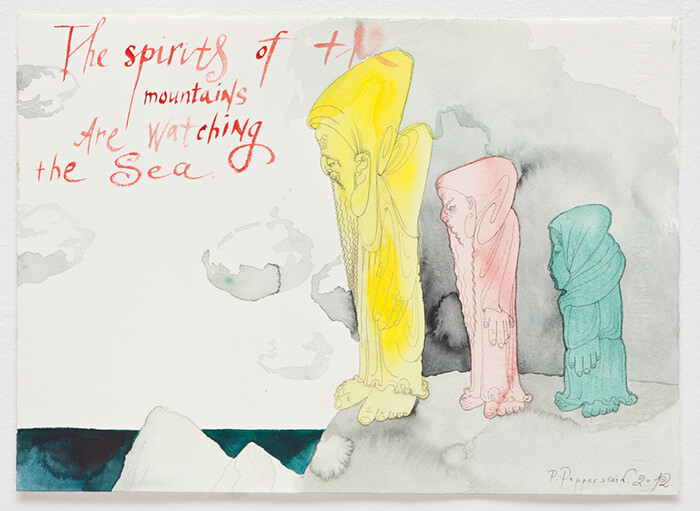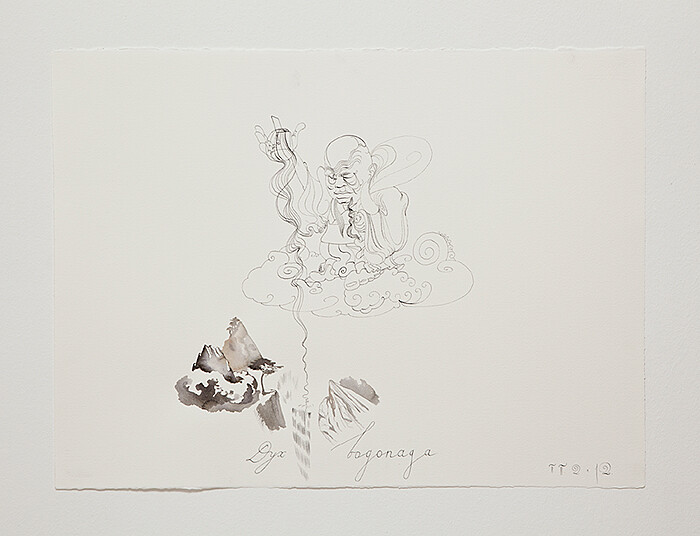What happens when semiotic experimentation, psychedelia, and storytelling meet? This seemed to be the question that underpinned the very peculiar practice of a collective called Inspection Medical Hermeneutics, founded in Moscow in 1987 by three young artists—Sergei Anufriev (*1964), Yuri Leiderman (*1963), and Pavel Pepperstein (*1966). Of the three, Pepperstein is the one who remained closest to the ideals of the group, which he further developed on two main fronts: as a fiction writer and as a visual artist. In his vast body of work, the artist has explored the possibilities of combining linguistics, outlandish experiments, popular narratives, and science fiction in a way that seems to be immune to the ideals and expressive forms of post-perestroika. In fact, Pepperstein often combines traditional formats, such as storytelling and figurative drawing, and in doing so he assumes a radical position: that of changing by not changing at all.
Such is the case of Pepperstein’s exhibition of twenty watercolors from 2012, some of which bring back figures that have previously emerged in the artist’s drawings, characterized by a unique combination of political, cultural, and folk references. Also in the show are drawings that evoke similar atmospheres; familiar characters are represented in different situations or contexts and organized into a thematic series.
There is a good rhythm in the display of the works, generated by a precise pace; it seems that we are walking through the pages of a storybook, each image corresponding to a new tale, and each space in between the turn of a page. The storybook impression is made all the stronger due to the fact that the margins remain empty, exactly like book pages. This white border produces a sort of symbolic frame that prevents contact with the real world that lies outside its boundaries.
Many of the mythical creatures born of Pepperstein’s prolific imaginary have Buddha-like faces: round, peaceful, large ears (perhaps better for listening). Most of them appear as solitary figures floating in the air, as in Untitled (The holy patron of the bridge); or in groups, as in Untitled (Unborn saints watch over the desert); many are adrift above arid, remote mountainous landscapes—Untitled (Covered by a coat, the guardian of the mountains)—while others hover above fantastic postmodernist cities, such as Untitled (The saint guardian of the ancient manuscript watches over the special operation); others are in more exotic locations, as in Untitled (The sleeping patron of a lake in the savannah, Kenya in 2888).
There is also a seemingly neat distinction between the two depicted worlds: the terrestrial and the celestial one, which is suggested not only by their respective above/below positioning on the page, but also by the stylistic differences between landscape and characters: if the mountains, lakes, cities, or deserts are exuberantly represented, rich and sensuous, most of the divinities are merely ghostly outlines in Indian ink.
Another set of drawings relates to the artist’s figuration of gangsters—a series that Pepperstein has been developing since the 1990s—which seems to be mostly informed by literature and Hollywood films. A strong dose of mordacious humor can be observed in Untitled (Oh, here is this fucking yellow triangle again!), in which two men wearing fedora hats and shades glare at a large yellow triangle. This is both an auto-referential line, as yellow triangles figure prominently in Pepperstein’s works, and a sort of humorist revisionism of Suprematism, which largely dismissed the use of the triangle, due to its religious and mystic connotations.
Unlike other of Pepperstein’s projects whose politics can be hard hitting, this show offers a rather harmless, poetic, amiable experience. Perhaps it leans towards being a bit too innocuous. Nonetheless, it succeeds in illustrating how decades of subtle and disguised critiques (evading the strict control of the Soviet regime) produced refined forms of dissent—where words of protest found inventive expression in images. As Lewis Carroll, the master of storytelling once said, “No, no! The adventures first, explanations take such a dreadful time!” In this show, Pepperstein seems to forego more explicit political accounts to focus on some whimsical getaways.






